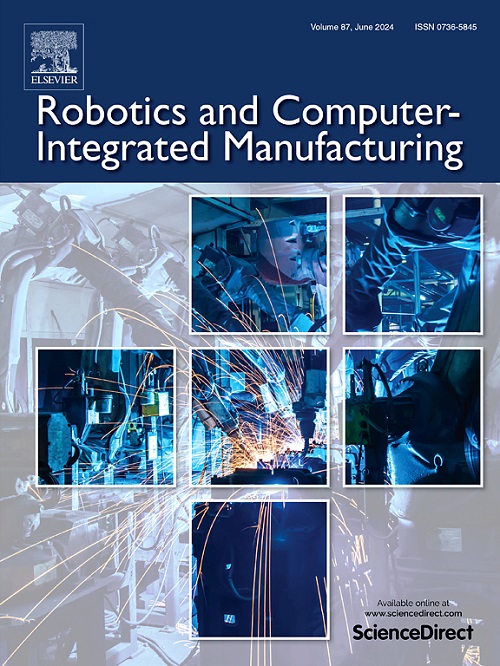A multi-level multi-domain digital twin modeling method for industrial robots
IF 11.4
1区 计算机科学
Q1 COMPUTER SCIENCE, INTERDISCIPLINARY APPLICATIONS
引用次数: 0
Abstract
Industrial robots (IRs) serve as critical equipment in advanced manufacturing systems. Building high-fidelity digital twin models of IRs is essential for various applications like precision simulation, and intelligent operation and maintenance. Despite technological potentials of digital twins, existing modeling methods for industrial robot digital twins (IRDTs) predominantly focus on isolated domains. This fails to address inherent multi-domain complexities of IRs that arise from their integrated mechanical-electrical-control characteristic. To bridge this gap, first, this study proposes a multi-level multi-domain (MLMD) digital twin modeling framework and method. The framework systematically integrates physical space, digital space, and their bidirectional interactions, while explicitly defining hierarchical structures and cross-domain mechanisms. Subsequently, a four-step method is established, which encompasses component analysis, parameter extraction, MLMD IRDT modeling based on function blocks (FBs), and model validation. Then, implementation details are illustrated through an SD3/500 IR case study, where domain-specific modeling techniques and cross-domain integration mechanisms are systematically analyzed. Finally, effectiveness and feasibility of the proposed method is validated through experiments.
工业机器人多级多域数字孪生建模方法
工业机器人是先进制造系统中的关键设备。构建高保真数字孪生模型对于精确仿真和智能运维等各种应用至关重要。尽管数字孪生具有技术潜力,但现有的工业机器人数字孪生建模方法主要集中在孤立的领域。这未能解决由其集成的机械-电气-控制特性引起的内在多域复杂性。为了弥补这一差距,本研究首先提出了一种多层次多域(MLMD)数字孪生建模框架和方法。该框架系统地整合了物理空间、数字空间及其双向交互,同时明确定义了层次结构和跨域机制。随后,建立了成分分析、参数提取、基于功能块(FBs)的MLMD IRDT建模和模型验证四步方法。然后,通过SD3/500 IR案例研究说明了实现细节,其中系统地分析了特定于领域的建模技术和跨领域集成机制。最后,通过实验验证了所提方法的有效性和可行性。
本文章由计算机程序翻译,如有差异,请以英文原文为准。
求助全文
约1分钟内获得全文
求助全文
来源期刊
CiteScore
24.10
自引率
13.50%
发文量
160
审稿时长
50 days
期刊介绍:
The journal, Robotics and Computer-Integrated Manufacturing, focuses on sharing research applications that contribute to the development of new or enhanced robotics, manufacturing technologies, and innovative manufacturing strategies that are relevant to industry. Papers that combine theory and experimental validation are preferred, while review papers on current robotics and manufacturing issues are also considered. However, papers on traditional machining processes, modeling and simulation, supply chain management, and resource optimization are generally not within the scope of the journal, as there are more appropriate journals for these topics. Similarly, papers that are overly theoretical or mathematical will be directed to other suitable journals. The journal welcomes original papers in areas such as industrial robotics, human-robot collaboration in manufacturing, cloud-based manufacturing, cyber-physical production systems, big data analytics in manufacturing, smart mechatronics, machine learning, adaptive and sustainable manufacturing, and other fields involving unique manufacturing technologies.

 求助内容:
求助内容: 应助结果提醒方式:
应助结果提醒方式:


